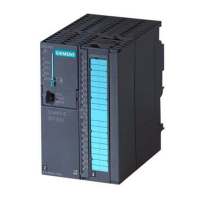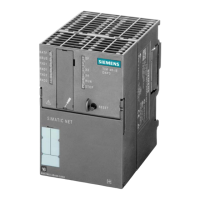Linking and Synchronizing
6-23
Automation System S7-400H Fault-tolerant Systems
A5E00068197-07
5. From formula [1]:
T
P15
(DP master system_1)
= 1250 ms – (2 × 25 ms + 300 ms + 50 ms + 100 ms + 30 ms) = 720 ms
T
P15
(DP master system_2)
= 1200 ms – (2 × 30 ms + 300 ms + 50 ms + 80 ms + 50 ms) = 660 ms
Check: if T
P15
> 0, continue with
6. T
P15_HW
= MIN (720 ms, 660 ms) = 660 ms
7. From formula [2]:
T
P15_OD
= 50 ms + T
PH
= 50 ms + 90 ms = 140 ms
Check: if T
P15_OD
= 140 ms < T
P15_HW
= 660 ms, continue with
8. From Section 6.3.4 for 170 Kbytes user program data:
T
P15_AWP
= 194 ms
Check: if T
P15_AWP
= 194 ms < T
P15_HW
= 660 ms, continue with
9. Formula [3] now provides the recomm. max. blocking time for priority classes
> 15:
T
P15
= MAX (194 ms, 140 ms)
T
P15
= 194 ms
Entering 194 ms for the maximum blocking time for priority class > 15 in STEP 7
ensures that a signal change during the update will always be recognized when the
signal lasts 1250 ms or 1200 ms.
Remedies if it is not possible to calculate T
P15
If no recommendation results from the calculation of the maximum blocking time
for priority classes > 15, you can remedy this by various measures:
• Reduce the watchdog interrupt cycle of the watchdog interrupt configured.
• For particularly high T
TR
times, divide the slaves into several DP master
systems.
• Increase the transmission rate on DP master systems affected.
• Configure the DP/PA links and Y links in separate DP master systems.
• If the DP slaves have very different switch-over times and thus (generally) great
variations in T
PTO
, distribute these slaves among a number of DP master
systems.
• If only a small load due to interrupts or parameter assignment is to be expected
in the individual DP master systems you can also reduce the T
TR
times
calculated by approx. 20–30%. This will increase the risk of a station failure
occurring in the distributed I/O.

